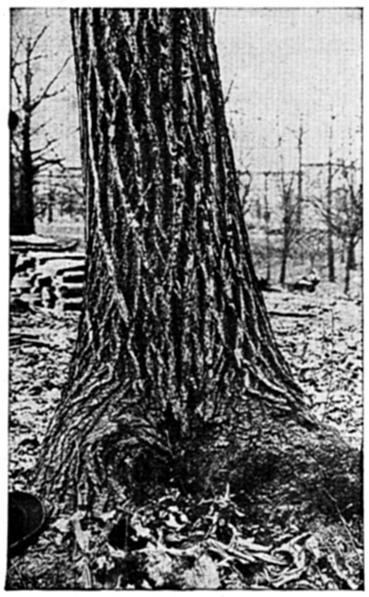|
==============================================================================
TOPIC: Studies of Trees 1914- American Chestnut
http://groups.google.com/group/entstrees/browse_thread/thread/e1c9e0f215430ed9?hl=en
==============================================================================
== 1 of 6 ==
Date: Tues, Jul 8 2008 6:40 pm
From: "Edward Frank"
Studies of Trees
by J. J. Levison, M.F.
Lecturer on Ornamental and Shade Trees, Yale
University Forest School;
Forester to the Department of Parks, Brooklyn, N. Y.
First Edition
First Thousand
1914
Chestnut (Castanea dentata)
Distinguishing characters:
The bark in young trees is smooth and of a marked
reddish-bronze color, but when the tree grows older, the bark breaks
up into diamond-shaped ridges, sufficiently
characteristic to distinguish the tree at a glance, see Fig.
65. A close examination of the terminal twig will
show three ridges and two grooves running down
along the stem from the base of each leaf or leaf-scar. The twig has
no true terminal bud. The fruit, a large, round bur,
prickly without and hairy within and enclosing the familiar dark
brown, sweet edible nuts is also a distinguishing mark of the tree.
Leaf: The leaves are
distinctly long and narrow. They are from 6 to 8 inches long.
Form and size: The
chestnut is a large tree with a massive trunk and broad spreading
crown. The chestnut tree when cut, sprouts readily from the stump
and therefore in places where the trees have once been cut, a group
of two to six trees may be seen emerging from the old stump.

Figure 65: Trunk of Chestnut Tree
Range: Eastern United
States.
Soil and location: It
will grow on rocky as well as on fertile soils and requires plenty
of light.
Enemies: During the past
nine years nearly all the chestnut trees in the United States have
been attacked by a fungus disease (Diaporthe
parasitica, Mur.) which still threatens the entire extinction of
the chestnut trees in this country. No remedy has been discovered
and all affected trees should be cut down and the wood utilized
before it decays and becomes worthless. No species of chestnut tree
is entirely immune from this disease, though some species are highly
resistant.
Value for planting: The
chestnut is one of the most rapidly growing hardwood trees but, on
account of its disease, which is now prevalent everywhere, it is not
wise to plant chestnut trees for the present.
Commercial value: The
wood is light, not very strong and liable to warp. It is durable
when brought in contact with the soil and is therefore used for
railroad ties, fence-posts, poles, and mine timbers. It is also
valuable for interior finish in houses and for fuel. Its bark is
used in the manufacture of tanning extracts and the nuts are sold in
cities in large quantities.
|